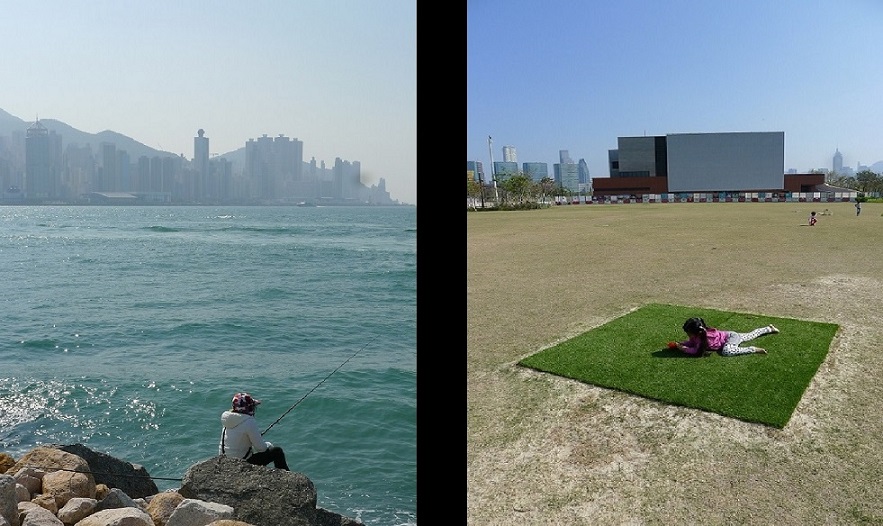Reviews & Articles
戲曲中心的前路及前往西九龍文化區攻略 | The way ahead for the Xiqu Centre & (literally) getting to the West Kowloon Cultural District
John BATTEN
at 2:53pm on 25th February 2019

圖片說明Caption:
西九龍文化區:1. 海濱垂釣 (左);草地嬉戲 (右);2. 停泊在鄰近碼頭的小船。照片: 約翰百德
West Kowloon Cultural District: 1. fishing on the harbourfront (left); playing on the lawn (right); 2. boats docked at nearby pier. Photo: John Batten.
(Please scroll down for English version)
位於西九龍文化區的戲曲中心正式前綵開幕之時,也傳來了戲曲團體的投訴,指中心場租太貴。說真的,戲曲團體認為耗資數千萬興建的新落成場地,租金會是多少?香港其他表演場地一直都有照顧中國戲曲的演出,戲曲中心在公演中國戲曲方面並無壟斷地位。高山劇場、油麻地戲院和私人擁有的新光劇院的租場費用,均有提供可負擔的租金,市場力量有可能影響戲曲中心的未來場租水平。在節慶期間,香港各處也會築起精彩的臨時戶外戲棚。我最喜歡的是盂蘭節時石塘咀陡峭山道天橋下的潮劇。這是一個令人意想不到,充滿未來感的地點,與戲曲表演、佛經誦念和等待善信與長者領取的平安米形成強烈對比。
依我估計,戲曲中心(特別是座位僅僅超過1,000的大劇院)將演化為各類音樂會、劇場、電影和音樂活動的場地,而不會只上演中國戲曲。中心開幕不久便這樣說,可能有點大言不慚,但供現場演出的場地,事實上必須做到多層次。如果套用政府喜歡的恐怖建築類別,場地必須為「多用途」。一個良好、具有彈性的舞台,連同寬闊的側廳,可以舉辦各種現場表演。戲曲中心的大劇院也設有樂團池,意味各種類型的音樂都可以在那裡演出……搖滾音樂會又有何不可?
把場地命名為戲曲中心,令人預期它只是為中國戲曲而設。有關場租的投訴,很可能正是源於這種預期。令香港戲迷(特別是粵劇迷)略感安慰的,是戲曲藝術肯定可以在未來得到政府支持。獨立戲曲演唱家、音樂家、劇團和場地將繼續得到資助,而唯一需要降低的預期,就是戲曲中心不一定永遠只供他們使用。
在戲曲中心開幕不久的數天,我在一個風和日麗的日子到訪了西九龍文化區。這是每年來看看西九的好時間,也是農曆新年後的最佳活動。我已有數月未有來訪,這次是專程過來參觀M+展亭正在舉行的野口勇展覽。但是要找到M+展亭卻有一定難度。我這樣建議:盡量不坐港鐵過來,否則便要一路到處尋找隱蔽的出口,還要經過像迷宮一樣的巴士站。只要走出圓方商場的外牆,便幾乎沒有可能找到正確路線。
我的常用策略是從港島乘坐西隧隧巴,然後在過海後第一個巴士站下車;914是車費最便宜的。在樓梯附近,我小心越過巴士站後面的圍欄(相對於直接經隧道連接路的5米路程,要爬樓梯再使用行人天橋實在太令人煩厭了!)。沿小路走幾米便會來到西九文化區的入口,這裡也可以通往設有圍欄的寵物公園,後面是貨櫃裝卸區。家有毛孩的話不妨帶牠一起來,西九公園歡迎小狗進入。我在這裡短暫繞道去觀看靠著碼頭停泊的小船,每次看到碼頭邊和船側都掛上了大車胎,總是感到一點訝異。然後我會緊隨指往M+展亭的指示牌,沿著海濱的步道繼續走,最後來到青葱怡人的露天草地。天氣好的話,大可預先準備食物,在草地上來個小野餐,順道飽覽遼闊的港島和九龍美景。
然後,再跟著指示牌沿即將竣工的圍封公園工地往前走。細小的 M+展亭便會在你眼前風景以凹位現身,在它身後的正是呈倒置「T」形、興建中的M+博物館。M+展亭內現正舉辦精彩非常的展覽,主角是美國/日本藝術家、雕塑家、園景建築師和設計師野口勇,請觀賞它的介紹短片、細閱展覽小冊子和參觀展品,你將可透過這位雕塑及公共空間設計大師,加深自己對現代主義和大自然美學的認識。離開展覽後,想想野口勇會如何設計西九龍文化區的露天空間。它一定不會像現在這樣!
參考資料:
www.westkowloon.hk/tc/the-district/architecture-facilities/xiqu-centre
www.westkowloon.hk/tc/counterpoint
|
原文刊於《明報周刊》,2019年2月16日
The Way Ahead for the Xiqu Centre & (literally) Getting to the West Kowloon Cultural District
by John Batten
The Xiqu Centre at the West Kowloon Cultural District opened with an official ribbon-cutting and, simultaneously, complaints from Chinese opera groups that the Centre''s hirer''s fee was too high. But, realistically, what rental did Chinese opera groups expect for a new multi-million dollar venue? Chinese opera is well-catered for by other venues in Hong Kong; the Xiqu Centre doesn''t hold a monopoly on space devoted to Chinese opera. Affordable rentals are available at the Ko Shan Theatre, the Yau Ma Tei Theatre and the privately-owned Sunbeam Theatre – market forces might influence future hirer’s charges at the Xiqu Centre. There are also the fabulous temporary outdoor bamboo pavilions constructed throughout Hong Kong during festivals. My personal favourite is the Chiu Chow opera performed during the Yu Lan (Ghost) Festival along the steep Hill Road in Shek Tong Tsui directly under the flyover. It is an unlikely, futuristic location; such a contrast to the opera performances, Buddhist chanting and piles of rice bags waiting to be distributed to donors and the elderly.
I envisage the Xiqu Centre - especially the Grand Theatre that seats just over 1,000 people - to evolve as a venue for all sorts of concerts, theatre, film and musical events, not just for Chinese opera. This might be a sacrilegious opinion so soon after its opening, but the reality of live venues is that they must be multi-layered and, to use that horrible category of architectural design favoured by government, they should be ‘multi-purpose’. A good flexible stage with generous wings allows a venue to host all sorts of live performances. The Xiqu Centre''s Grand Theatre also has an orchestra pit, so music of all genres could be performed there…and, why not rock concerts?
Naming the venue as the Xiqu Centre has created an expectation that the venue is only devoted to Chinese opera. Complaints about hirer''s costs probably emanate from that expectation. If there is a consolation for Hong Kong''s Chinese (particularly Cantonese) opera buffs is that future government support for Chinese opera is assured. Subsidised support for independent Chinese opera singers, musicians, troupes and venues will continue and the only lowering of expectations is that the Xiqu Centre won''t always be exclusively available to them.
Coinciding with the Xiqu Centre’s opening days, I visited the West Kowloon Cultural District on a beautiful sunny day. It is an excellent time of the year to visit and a perfect post-Chinese New Year activity. I had not been for some months and aimed to see the excellent Isamu Noguchi exhibition at the M+ Pavilion. However, it can be tricky finding the M+ Pavilion. Can I advise: I avoid arriving by MTR, it is a trek finding obscure exits and through the labyrinthine bus station. It is then almost impossible to find the right route once you are outside the walls of Elements shopping centre.
My usual strategy is to catch a bus running through the Western Harbour Tunnel from Hong Kong Island, bus number 914 is the cheapest, and get off at the first stop after the tunnel. Near the staircase, I carefully jump the fence running along the back of the bus stop (using the staircase and pedestrian bridge is too tedious compared to the direct 5 metre walk across the Tunnel''s slip-road!). There is an entrance into the WKCD a few metres along the footpath, which also leads to a container unloading area just behind the fenced pet park. Take a dog if you have one, they are allowed into the West Kowloon park. I detour briefly to look at the boats docked alongside the pier, always amazed by the huge tyres strapped to the pier edge and boats’ sides. Then, strictly following the signage pointing to the M+ Pavilion, stay on the footpath running alongside the harbour; this will take you to a lovely open grassed area. Prepare some food beforehand and have a picnic on the grass if the weather is good. You will have excellent panorama views of Hong Kong Island and back towards Kowloon.
Then, walk alongside the fenced-off construction site as the park nears completion, still following the signage. The small M+ Pavilion will emerge from a dip in the landscape and behind it is the under-construction inverted ‘T’ of the new M+ Museum. The current exhibition inside the M+ Pavilion featuring the American/Japanese artist, sculptor, landscape architect and designer Isamu Noguchi is excellent – watch the introductory video, read the pamphlet and look at the displays – you will learn about the aesthetics of modernism and nature through this master sculptor and designer of public spaces. After leaving the exhibition, consider how Noguchi may have tackled the design of the open areas of the West Kowloon Cultural District. It certainly wouldn’t be like it is!
Links for further info:
www.westkowloon.hk/en/the-district/architecture-facilities/xiqu-centre
www.westkowloon.hk/en/counterpoint
This article was originally published in Ming Pao Weekly, 16 February 2019. Translated by Aulina Chan.
